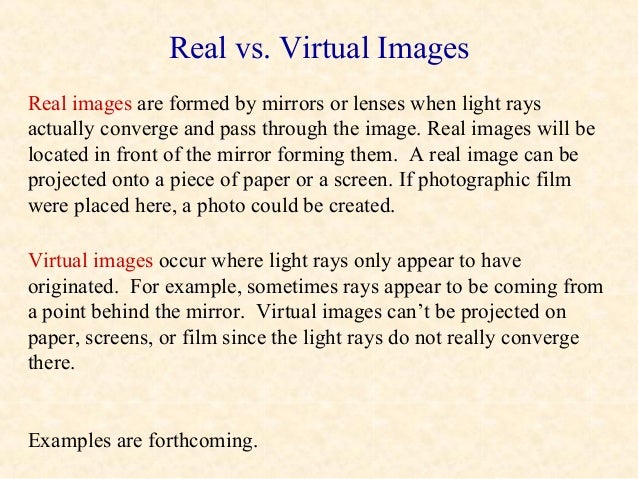
By the intersecting rays, the real images are produced, and by diverging rays, the virtual images are produced. Reflection in the mirror is the best example of a virtual image. Hence, the distance between the image and the object is OX + OY = 2OY(as OX = OY) OY - is the distance of the object from the mirror OX - is the distance of the image from the mirror People can see the image as a real image can be projected onto a diffusely reflecting screen(the image on the screenplays as an object to be imaged by human eyes)Īn example of a virtual image formed by a concave mirror and plane mirror given below: Since the rays don't converge, a virtual image cannot be created on a screen, but a real image can be produced on a screen as the rays converge on a real location. In the diagram of the optical system, the dotted lines represent the conventional virtual ray. A virtual image is formed by tracing real rays that arise from an optical device like a mirror or lens, backward to apparent origins of ray divergences.

#Real vs virtual image full#
In the diagrams below, real rays of light are represented by full solid lines, or generalized rays of light are represented by dashed lines.Ī range of focus points formed by the converging rays is known as a real image, while the collection of focus points made by the extension of diverging rays is known as the virtual image. The image is created on a detector in the rear of a camera or the image produced on the retina of the eyeball (they focus light through an internal convex lens). This reflects the image on the screen, which plays the object to be imaged by human eyes. The most common example for a real image is the image on the cinema screen as the object is being projected on the screen with the help of a projector. This is similar to what you would get in the case of a concave mirror except for the object placed at a distance equal to or less than the focal point you will get a real image.Īs per the below diagram, a real image is formed by a convex lens, and one real image is formed by a concave mirror. The backward extension of refracted or reflected light rays is true for a virtual image that is, it doesn't exist in reality.įor a convex lens, placing an object at or near a distance equal to or less than the focal length will give you a real image. When the light rays after refraction or reflection meet at a point, it exists in reality, meaning a real image can be placed on the screen. Space is not the same as from the object to the lenses. As the object nears the focal point, the image will move towards infinity, and when the object surpasses the focal point, the image becomes virtual and is upright. By usage of concave mirrors and converging lenses, a real image can be produced, but on the condition that the object is placed further away from the mirror/lens than the focal point, and the real image is inverted. When rays converge, real image occurs, and when rays only appear to diverge, virtual image occurs.

In simplistic terms, an image located in the plane of convergence for the light rays emitted from an object known as a real image. An assortment of focus points made by the converging rays is known as a real image, whereas the collection of focus points made by the extension of diverging rays is known as the virtual image. Now, let us understand what real and virtual images are:Ī compilation of focus points of light rays emitting from an object defined as an image in terms of optics. Real and Virtual Images: Differences using Concave/Convex Mirrors This page will help us understand the different types of images formed on mirror along with their distinction. Some of these rays which represent the light reach the mirror's surface and reflect off the surface as per the laws of reflection.ĭo you know what significance these images have and in what terms they vary? The word object in the definition can be anything that emits light rays.Īs light is emanating from an object in a variety of directions, an image is formed.

Do you know what a mirror image is? Well! When the light rays coming from an object appear to meet at a point after reflection or refraction, the point may be defined as an image.


 0 kommentar(er)
0 kommentar(er)
